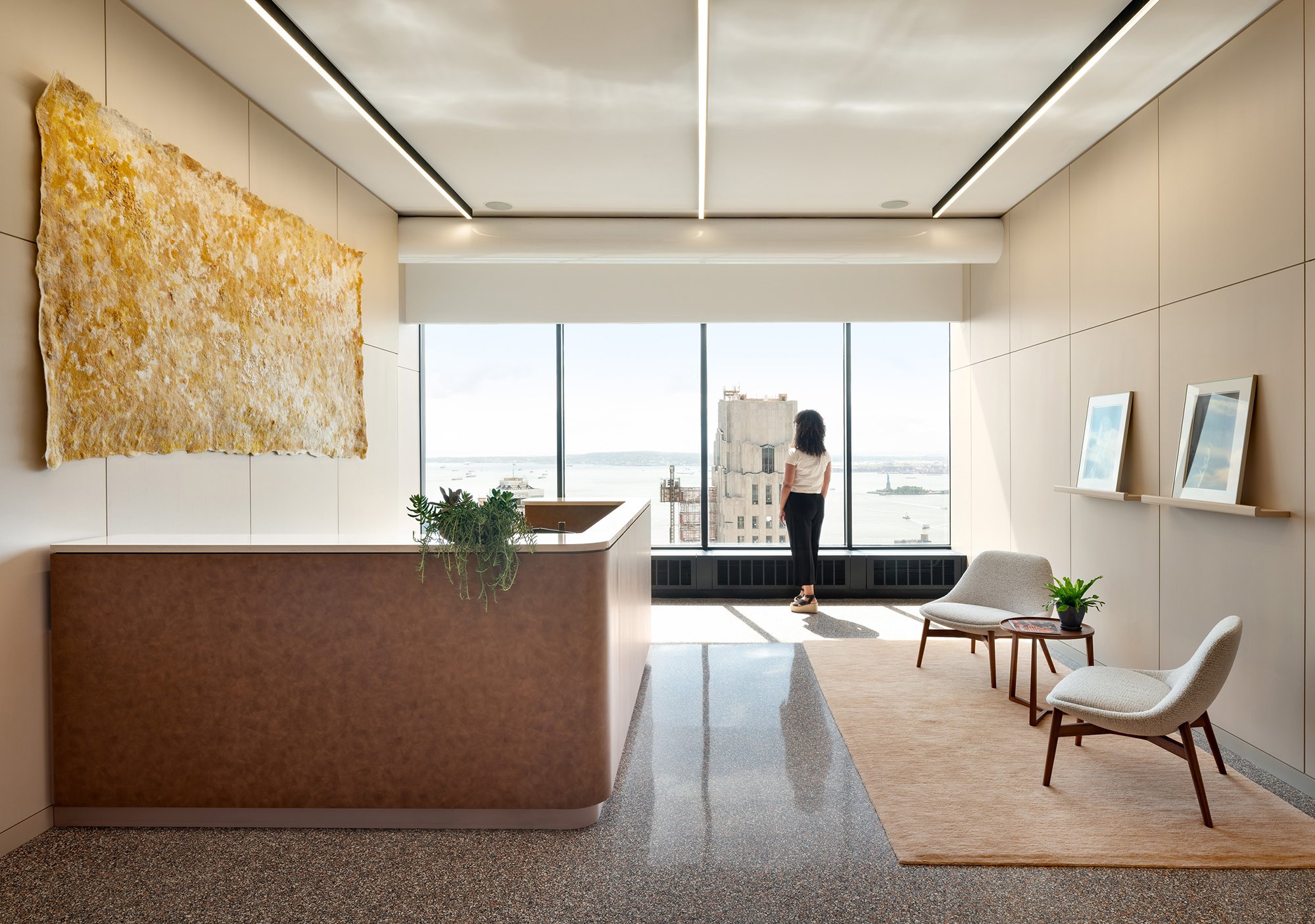Where Residential Design Can Take You
How Interior Designer Kiki Dennis ’00 (AAS) Became a Leader at an Architecture Firm
Kiki Dennis. Photo by Winnie Au.
NYSID Alumna Kiki Dennis ’00 (AAS) built her own successful residential interior design firm. Then, she became a partner and residential interiors co-lead at the architecture firm Deborah Berke Partners. An interior designer who leads at an architecture firm, she thrives in a collaborative and multidisciplinary environment. She discusses her career path, how she has applied her residential expertise to other sectors, and what it is about home design that continues to beguile her.
Even as a young adult, Kiki Dennis (née Jennifer Dennis) had a grasp of what she loved and what she wanted to do. She started out as an interior design major while pursuing her undergraduate degree at Cornell University but transferred to major in art history. She says, “Cornell’s program, at the time, was very commercially focused and I hadn’t really realized that when I applied. I was much more interested in residential design, specifically the decorative arts, art history, and antiques as they pertained to interior design.”
Looking for a change, she decided to transfer to Ithaca College to complete her BA in Art History. After she graduated, she debated about whether to take an academic path and pursue her Ph.D. in Art History, or to go into the practice of interior design. She says, “A major reason I came to NYSID is because they had such a strength in residential design and an unparalleled foundational education in decorative arts, art history, and historical styles. This is how I wanted to approach interior design and I was drawn to NYSID because it wove my interests together with the more practical programming aspects of design.” Dennis worked at NYSID first as an academic advisor and later as director of admissions while she pursued her degree.
More than two decades after Dennis’ graduation, a lot has changed at NYSID, but the emphasis on residential design as an essential rather than an elective component of interior design education has stayed the same. “We are one of the few interior design programs (in undergrad only) that devotes whole semester-long studios to residential design, breaking it out from other project types, such as commercial or institutional,” says Ellen Fisher, Vice President for Academic Affairs and Dean. “We do this to honor the legacy of the College, and to show that we value the rich history and deep knowledge of art, decorative arts, architecture, and interiors that are required in order to practice residential design.”
At NYSID, Dennis was lucky enough to experience some of the most celebrated teachers in NYSID’s history: the residential designers Ethel Rompilla, Melinda Bickers, and the late Anne Korman. Despite her desire to be a residential designer, Dennis’ very favorite class was Contract I, because it taught her how a central concept could drive a whole design process.
In 2000, Dennis landed her first job at the prestigious architecture firm Deborah Berke Partners (DBP) right out of her Associate’s Degree program at NYSID. One of the jurors of her final Contract Design project worked at the firm. After seeing her work, he invited her to apply for a job opening. Dennis loved the culture of Deborah Berke Partners from the start. At the time, DBP was one of the few woman-led architecture firms in the industry. “We were a much smaller firm back then, and we’ve grown, but what remains core to the culture of the company is a real focus on staff development and the growth of individuals,” she says. “I think that comes from Deborah’s long-standing career not only as an architect, but also as an educator.” (Deborah Berke has been a professor and is now dean of the Yale School of Architecture.)
Photos by Christopher Cooper, courtesy of DBP.
When Dennis had her first child, she realized she wanted a work schedule that allowed for greater flexibility. She left DBP and began teaching residential design studio courses at NYSID. It was through a collaboration with a colleague that she landed her first private commission for a house in the Hamptons. From that first project, her reputation for tranquil, modern, biophilic living spaces grew. In 2004, she decided to establish her own Brooklyn-based residential interior design firm, Kiki Dennis Interiors. Her spaces were especially notable for their sense of proportion, balance, and muted color palettes drawn from nature. Over the course of 12 years, she hired a small staff and built an impressive client roster, executing many residential projects in Brooklyn, and even one in Fiji.
In 2014, her family was getting ready to make a move to Austin, Texas, to accommodate a career opportunity for her husband, when there was unexpected upheaval at the firm her spouse had expected to join. At what was supposed to be a “farewell” dinner for Dennis, a partner at DBP learned that Dennis was not moving to Austin. He proposed the idea of returning to DBP as co-leader of the residential interiors practice. Dennis convinced her longtime project manager from Kiki Dennis Interiors to accompany her to DBP. “It was an amazing opportunity to rejoin a firm I’d loved and thrived in,” remembers Dennis. “Also, I’d learned from my own work that getting in early in the design process and collaborating with the architects from the outset of a major renovation or ground-up project makes for better outcomes.” Joining a team also gave her the opportunity to work on larger scale projects, something she felt she needed for her personal development as a designer. Over time, Dennis was promoted to partner.
“I think it’s rare to make an interior designer in an architecture firm a partner. It’s indicative of the amount of respect DBP has for interior design as a discipline,” Dennis says. She adds, “The design process is getting more complex all the time and we value a strong collaborative approach. Having varied voices around the table with different forms of expertise only makes a project better.” Collaboration fuels her creativity. In 2020, she worked with Deborah Berke and other partners and principals at her company to design a collection of hand-knotted wool and silk carpets for Warp & Weft.
Kiki Dennis now works on residential, commercial, and institutional projects at DBP. She says one of the things she values most about residential work are the close relationships with clients that continue long after the initial project has been completed. She’s also inspired by the movement toward using more sustainable and ethically sourced materials in residential interiors. “We’re finding our residential clients are interested in setting very high goals for sustainability in their spaces,” she says. “So, we are using a variety of methods to meet these goals from sourcing locally to using more vintage items.” She adds, “We have learned a lot from our work on commercial and institutional projects by focusing on the health of products in terms of off-gassing and toxicity, and we’re channeling this knowledge into residential projects.”
Long before “Resimercial” was a buzzword, Dennis was taking her residential lens into commercial projects. One of Dennis’ favorite projects was a headquarters and workspace for the Wallace Foundation, a nonprofit that brings equity and enrichment through the arts to everyone. Dennis found herself drawing on her vast knowledge of residential interiors to give this commercial project the desired effect. “The client wanted it to be a very warm and welcoming space that stimulated a work environment and culture that was aligned with their values and collaborative approach. We developed a color palette that set the inviting tone of the office. We also collaborated with the Dutch artist Claudy Jongstra on a site-specific installation that added drama and warmth to the communal spaces.” She says, “It’s been fantastic to work on smaller spaces for one family as well as larger-scale public spaces that impact the interactions of groups of people. Whether it’s a commercial or residential project, I cast a wide net in terms of finding inspiration from artists, craftsmen, and the natural world to discover the concepts that drive our projects.”





